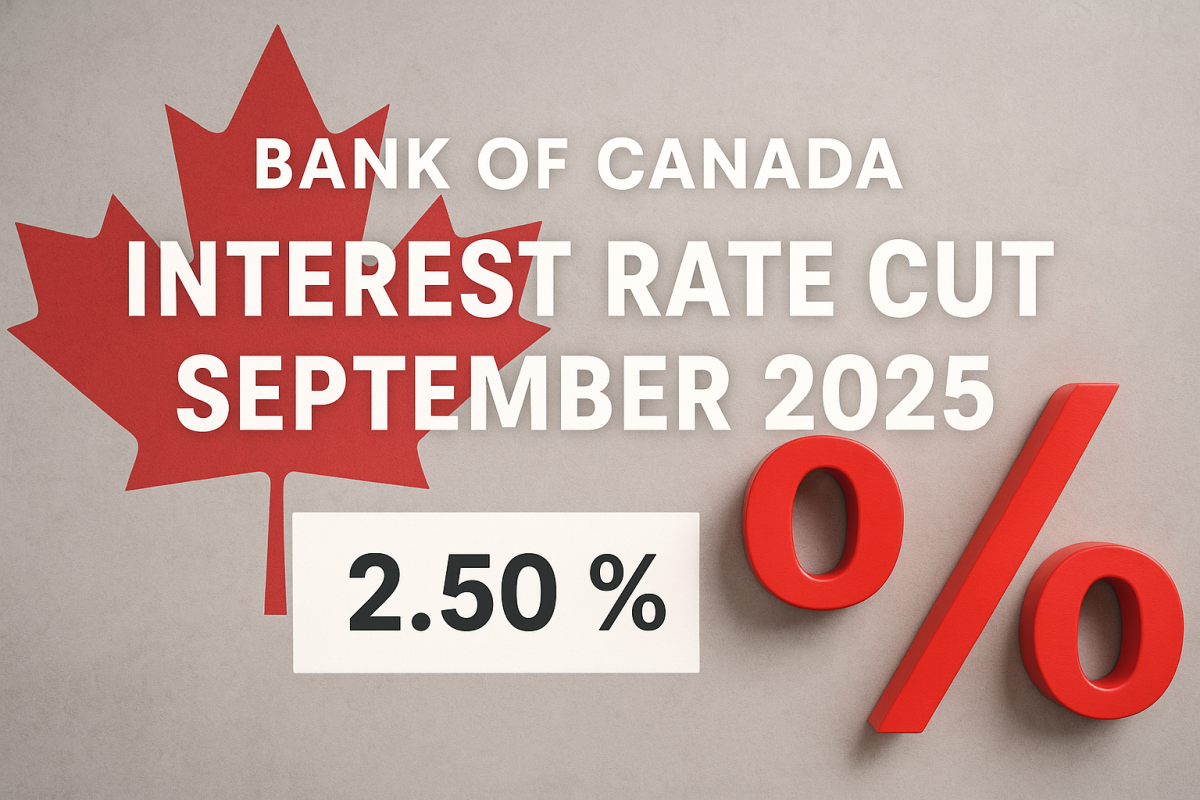Bank of Canada reduced its target for the overnight rate by 25 basis points, from 2.75 % to 2.50
Date: September 17, 2025
Action: Bank of Canada cut its target for the overnight rate by 25 basis points, from 2.75 % to 2.50 %. (Bank of Canada)
1. Why the Bank Made the Move
The Bank of Canada’s decision to cut the overnight rate didn’t come out of nowhere. Several economic indicators and risks have been coalescing to make easing more attractive. Some key drivers:
- Slowing economic growth: GDP contracted in Q2, showing signs of weakness. (Reuters)
- Labour market cooling: Job losses have mounted, the unemployment rate has risen. Wage growth is softening. (Reuters)
- Inflation risks easing: While inflation remains above 2 % depending on the measure, core inflation pressures seem to be stabilizing without many “upside” risks. The rise in inflation due to trade disruptions and tariffs is a concern, but the Bank judged that those pressures are lessening. (Reuters)
- Global uncertainty and trade tensions: Tariffs, trade policy uncertainty, and external shocks are weighing down both business investment and exports. The Bank considers these risks material. (Reuters)
So, in short: the Bank views the risk of economic underperformance as increasing, while inflation is more under control (or at least the upside risk has lessened). That combination makes a modest rate cut appropriate in their view as of mid-September.
2. What Exactly Changed
Here are the specifics of the decision:
| Parameter | Before | After |
|---|---|---|
| Target for the overnight rate | 2.75 % (Bank of Canada) | 2.50 % (Bank of Canada) |
| Bank Rate | 3.00 % (implicitly) (Bank of Canada) | now 2.75 % (Bank of Canada) |
| Deposit Rate | Previously 2.70 % (and other associated corridor rates) (Bank of Canada) | now 2.45 % (Bank of Canada) |
It’s the first cut since March 2025, and comes after a period in which the rate was held steady (including in July). (Bank of Canada)
3. Broader Economic Impacts & Risks
The implications—and risks—of this move are varied. Some will play out quickly, others over months.
Positive Impacts
- Borrowing costs ease: For variable-rate loans, lines of credit, mortgages with variable components, etc., monthly payments will tend to decline. This gives some breathing room for households with debt.
- Stimulus for investment and spending: Lower rates can help businesses that have been holding back on investment because of trade uncertainty, weaker demand, or financing costs. Lower carrying costs may also help sort-of “revive” some stalled projects.
- Support for real estate markets: Lower rates can help with housing affordability to some extent (especially for new buyers or those with adjustable/variable rate debt), or reduce pressure for those refinancing. Particularly important in places with high debt levels.
- Currency & trade effects: A rate cut can weaken the Canadian dollar relative to others, which could help exporters somewhat (though trade tensions complicate that). It might increase the price of imports, but given inflation pressures are already easing, the Bank likely judged this manageable.
Risks / Potential Downsides
- Inflation reigniting: If demand picks up faster than expected, or if external pressures (e.g. from tariffs, supply chain disruptions, energy prices) reappear, inflation could start moving up. The Bank will need to monitor carefully.
- Delayed effects: Monetary policy operates with lags. It’s not immediate; it takes time for cuts to influence spending, investment, hiring. If the economy deteriorates further before the cut has full effect, there’s a risk of recession or weak growth.
- Policy credibility: If inflation expectations become unanchored, or if markets read the move as premature, the central bank’s credibility could suffer. People expect inflation to remain stable around target; overshooting would invite criticism.
- Limited scope of impact: For many households, especially those on fixed mortgages, rent or other fixed costs, rate cuts won’t immediately change cashflow. Also, structural issues (like supply constraints in housing, or sector-specific trade disruptions) aren’t solved by rate cuts alone.
4. What It Signals About the Bank’s Outlook
Cutting the overnight rate suggests that the Bank of Canada now sees more downside risk than upside in the current economic trajectory. Some signals:
- More cuts may be coming: Economists had been expecting this cut; some believe at least one more cut could follow in 2025 if data doesn’t improve. (Reuters)
- Shorter forward horizon: The Bank’s communication suggests it will be more data-dependent, possibly placing less weight on long-run projections, focusing more on nearer term risks and outcomes. (Reuters)
- Inflation close to target, but uncertain: While headline inflation is within or near the target band (between 1-3 %), core inflation measures still need watching. The Bank seems somewhat relieved that many inflation pressures are easing, but not so much that they feel entirely relaxed.
5. Zooming in: Implications for Real Estate & Mortgage Markets
Mortgages & Debt Servicing
- Variable-rate mortgages: These will benefit the most immediately. As the overnight rate (and what banks pay to borrow money) drops, prime rates typically drop, meaning lower payments for those with variable or adjustable mortgages.
- Fixed-rate mortgages: Less immediate impact. Fixed rates are influenced by longer-term bond yields and long-term inflation expectations. If this cut leads to lower yields long-term, fixed mortgage rates may gradually decline, but not immediately.
- Mortgage renewals: For those coming off fixed-rate mortgages, or renewing, the environment may become more favorable—but lenders will factor in risk, expectations of future rate cuts, and inflation.
Housing Demand & Prices
- Potential for increased demand: Lower borrowing costs can encourage homebuying, particularly among those on the margin (first-time buyers, people waiting for lower rates).
- Affordability relief: Though interest rates are only one part of the cost of housing, any decline helps reduce carrying costs. But housing prices, supply constraints, property taxes, and other fixed costs still pose obstacles.
- Risk of overheating: In markets already tight or overheated, rate cuts can further fuel price growth unless supply responds. There’s always a risk of speculative behaviour, especially if people expect rates to stay low.
Real Estate Investment & Development
- Lower financing costs can improve project feasibility, especially for developers who rely on debt.
- But risk remains from other economic headwinds: weaker export demand, uncertainty in global trade, labour cost pressures, supply chain issues. Developers will be wary.
6. Context: Recent History & Policy Trajectory
Putting this cut in perspective:
- The overnight rate has been steadily lowered / adjusted since its peak in previous years. For example, cuts in earlier 2025 and before. (Bank of Canada)
- The Bank had held its rate at 2.75 % over several meetings (including July 30) despite mounting pressures, indicating caution. (Bank of Canada)
- Market expectations had been aligning with a 25 bp cut for the September announcement, with some expecting additional cuts later in the year depending on how inflation and growth evolve. (Global News)
7. What to Watch Next: Key Indicators
Bank of Canada interest rate cut September 2025
To track whether this rate cut delivers what the Bank hopes, and to anticipate what comes next, these are the main metrics and data points to watch:
- Inflation & Core Inflation Measures
- CPI headline
- CPI-trim, CPI-median (or other core measures)
- Inflation expectations surveys
- Labour Market Data
- Unemployment rate
- Participation rate
- Wage growth
- GDP Growth
- Especially quarterly growth, but also early monthly indicators (retail sales, manufacturing, services).
- Trade and Global Risks
- Tariff developments, trade agreements, global supply chains.
- External demand for Canadian exports.
- Consumer & Business Confidence / Investment
- Are businesses ready to invest, or are they still in wait-and-see mode?
- Household debt loads & savings behaviour.
- Financial Markets
- Bond yields (especially medium-to-long term yields)
- Exchange rate movements
- Mortgage rate spreads
8. What This Means for Different Stakeholders
- Homeowners with variable mortgages or those renewing fixed mortgages soon may see lower monthly payments or be able to negotiate better terms.
- Prospective homebuyers: More favourable borrowing conditions may shift timing decisions (e.g. might accelerate purchases if they expect rates to rise again or if prices continue up).
- Real estate investors and developers: Lower cost of capital improves project returns, but must still factor in risk from inflation, supply constraints, and policy uncertainty.
- Lenders / Mortgage providers: Will need to adjust their portfolios, possibly lower fixed vs variable rate offerings, manage interest rate risk.
- Policy watchers / Government: The Bank’s cut may relieve some pressure on households and stimulate growth, but budgetary and regulatory policy will still matter (housing supply, tax policy, etc.).
9. My Perspective / What I Think will Happen
Given everything:
- I believe this rate cut was justified. The Bank had room to move given cooling labour markets and evidence that inflation pressures are lessening.
- I expect we will see at least one more rate cut before the end of the year if the data does not unexpectedly worsen. But the Bank will proceed cautiously; if inflation picks up or supply shocks reappear, they may hold or even consider tightening again.
- For the real estate sector, this may provide modest short-term relief and possibly boost demand among buyers waiting for better conditions. However, I don’t expect a major swing—housing stock, affordability, regulatory issues, and supply remain dominant constraints.
- One risk I see: The Bank might be lured into being more aggressive if growth disappoints strongly, which could run the risk of inflation creeping back if supply issues aren’t addressed or if global commodity prices rise.
10. Final Thoughts
The September 17, 2025 cut in the overnight rate to 2.50 % marks a clear tilt toward supporting growth in Canada, while still keeping inflation under watch. The Bank of Canada is balancing a tricky line: easing enough to respond to softness in the economy, but trying not to overshoot and risk re-igniting inflation pressures.
For anyone in mortgages, real estate, finance, or business more broadly, this is an important signal: borrowing is a bit cheaper, but uncertainty remains high. How things play out will depend heavily on external risks (trade, global slowdown), how households manage their debt, and whether inflation stays subdued.



